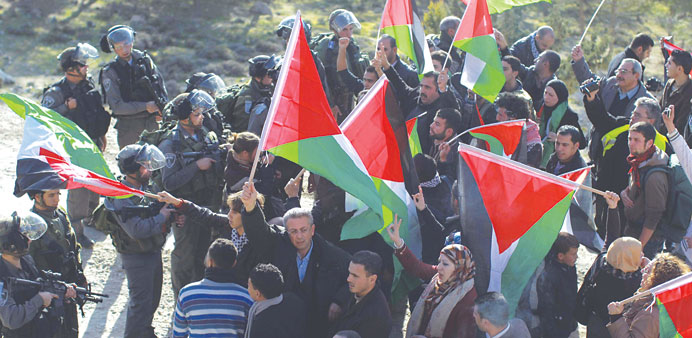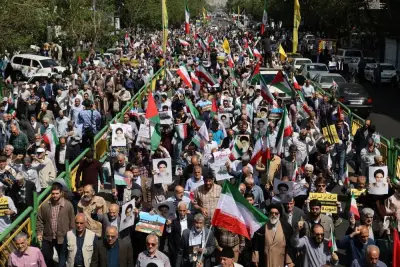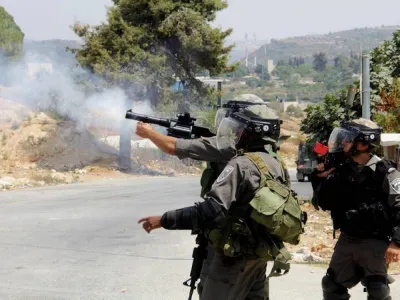Agencies/E1, West Bank
Israeli police, using stun grenades, blocked about 50 Palestinian activists who tried yesterday to reoccupy tents they pitched last week on a patch of West Bank land which Israel wants for Jewish settlements.
Israel has drawn strong international criticism over plans to build settler homes in the area, known as “E1”, which connects the two parts of the Israeli-occupied West Bank outside Arab suburbs of East Jerusalem.
On Sunday, hundreds of police officers evicted the protesters, who had claimed the area in the name of a future Palestinian state. The large, steel-framed tents remained standing at the site pending the outcome of Israeli Supreme Court hearings on Israel’s intention to remove them.
Protesters who tried to return to the tents yesterday were confronted by police officers who told them the site had been designated off-limits by the army.
One activist wore a white bridal gown and their cars were decked out in bright ribbons, making the protest look like a traditional Palestinian wedding.
“The protesters continued to make their way up. Police pushed the protesters back down the hill,” police spokesman Micky Rosenfeld said. “Two stun grenades were used to disperse the protesters and prevent attempts to climb back up.”
Twenty Palestinians were detained for questioning, he said.
For years Israel froze building in E1, which houses only a police headquarters, after coming under pressure from former US President George W Bush to keep the plans on hold.
But Prime Minister Benjamin Netanyahu announced plans late last year to expand settlements after the Palestinians won de-facto statehood recognition at the UN General Assembly in November.
Many countries view Jewish settlement building in areas captured by Israel in a 1967 war as illegal and echo Palestinian concerns such construction could deny them a viable and contiguous state.
E1 covers some 12sq km and is seen as particularly important because it not only juts into the narrow “waist” of the West Bank, but also backs onto East Jerusalem, where Palestinians want to establish their capital.
About 500,000 Israelis and 2.5mn Palestinians live in the West Bank and East Jerusalem. Direct peace talks between Israel and the Palestinians broke down in 2010 over the issue of Israel’s continued settlement building.
*Israel’s former foreign minister Avigdor Lieberman yesterday dismissed Palestinian anger over his pre-election visit to Hebron’s Tomb of the Patriarchs, with a spokesman stressing he was only at the Jewish section of the site.
Lieberman, who heads the hardline nationalist Yisrael Beitenu party, visited the site which is holy to both Jews and Muslims and under Israeli control on Monday, sparking an angry reaction from the Palestinians who called it a “provocation”.
Built over the spot where the biblical figure Abraham is believed buried, the Tomb is known to Muslims as the Ibrahimi mosque, with half of it used as a synagogue.
Lieberman paid a brief visit to the synagogue, read a few psalms, said a prayer, than left, while recalling a similar visit during the 1996 election when he was with the right-wing Likud party which ended up winning and putting Netanyahu in office for the first time.
“This same impulse to visit here returned, and before this election, I felt I had to come here,” he said in remarks quoted by a spokesman.
Palestinian government spokeswoman Nur Odeh had condemned the visit as “a provocation” by a public Israeli figure known for his “aggression against the Palestinian people and who supports settlement”.
“We see any attempt by any Israeli to involve religious sites in the confrontation as completely unacceptable,” she said.
Lieberman’s Yisrael Beitenu is running on a joint ticket with Netanyahu’s Likud with the list expected to easily win the contest.

Israeli border police argue with Palestinian activists trying to reoccupy the protest camp in the E1 area of the West Bank yesterday.


